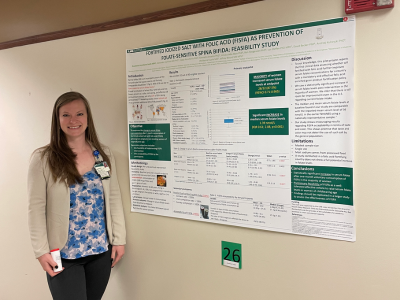 The UAB Department of Neurosurgery Division of Pediatric Neurosurgery’s Regan Gaskin, MPA, Tori Caudill and Anastasia Smith, MPH, presented their individual research projects during recent poster presentation sessions across UAB.
The UAB Department of Neurosurgery Division of Pediatric Neurosurgery’s Regan Gaskin, MPA, Tori Caudill and Anastasia Smith, MPH, presented their individual research projects during recent poster presentation sessions across UAB.
Caudill, clinical research coordinator II, and Smith, clinical research manager, were each awarded first place for their respective poster presentations.
Tori Caudill
Caudill presented her research, “Screening for eating disorders in adolescents and young adults with spina bifida,” during the School of Health Professions Research Day. Caudill’s research focused on the rate of eating disorders in spina bifida patients.

After analyzing self-reported eating disorder pathology data, Caudill found that more than half of the study participants met the Diagnostic and Statistical Manual of Mental Disorders, Fifth Edition (DSM-V) criteria for an eating disorder. Lower self-esteem, lower body appreciation, and higher depression were all considered predictors of an eating disorder.
Caudill’s research showed that, when comparing obese to non-obese participants, 73% of the obese cohort not only met the established criteria for an eating disorder but were more likely to engage in restrictive behaviors and judge themselves based on weight or shape.
Caudill concluded that unbridled weight stigma may influence disordered eating behaviors under the guise of promoting weight loss and weight management for improved health in the spina bifida patient population.
“I strongly believe that eating disorders are more common than we realize because society has endorsed a specific “image” related to what a person with an eating disorder looks like,” said Caudill, a long-time advocate for eating disorder awareness in underrepresented populations. “With my research, I’m looking to break that stigma and propose alternative ways to evaluate health that aren’t specific to body weight or shape.”
Caudill is currently working with UAB Department of Nutrition Sciences Associate Professor Eric Plaisance, Ph.D., to research weight cycling and the effects of exogenous ketones in various populations.
Regan Gaskin
At the 2024 UAB Health Equity Research Symposium: Achieving Health Equity Through Community Engaged Research and the School of Health Professions Research Day, Gaskin, a clinical research coordinator II, presenter her project, “Emergency department utilization amongst patients considered high risk for lung cancer at UAB.” Gaskin’s research examines the demographics of individuals considered at high risk for lung cancer who received low-dose computed tomography (CT) at UAB and visited the UAB Emergency Department (ED).

After performing a mixed effects logistic regression analysis of the data collected, Gaskin found that Black individuals and individuals aged 38 to 49 years were more likely to visit the ED compared to individuals that were female, married, insured through Medicare or a private company or were aged 65 years or older.
According to Gaskin, “Emergency department utilization differs for certain groups, and identifying factors associated with higher ED utilization can be used to optimize resource allocation, improve patient management, and inform patient education materials. Additionally, this methodology can be extended to different at-risk groups or other chronic conditions.”
Anastasia Smith
Smith presented her research, “Fortified iodized salt with folic acid (FISFA) as prevention of folate-sensitive spina bifida: feasibility study,” at the UAB School of Public Health’s annual Public Health Research Poster Session.
The fortification of enriched grain products using folic acid is well-known to reduce neural tube defect development rates, but is used in only a few countries, likely due to the lack of a universal food vehicle for fortification. Smith’s research assessed the potential of using salt as a new staple fortification vehicle because of its wide availability. Smith’s primary objective was to examine the change of folate levels in the blood (serum folate concentration) among a multi-race cohort of non-pregnant, non-lactating women of reproductive age after regular consumption of fortified iodized salt with folic acid (FISFA).

Study participants received a saltshaker filled with the study salt, measured at one gram of sodium chloride salt fortified with 100 mcg of folic acid, to use in place of regular table salt for one month. After analyzing the data collected post-intervention, Smith determined that FISFA implementation was both feasible and acceptable, with 88% of participants experiencing an increase in measured folate levels.
“FISFA is an effective approach to increasing serum folate concentrations among women of childbearing age, even in a country that has effective mandatory fortification of certain grains. In the U.S. about 20% of the population has sub-optimal levels of folate,” said Smith. “This study also shows promise for global efforts to prevent hundreds of thousands of cases of spina bifida.”
Smith plans to continue her research on the use of FISFA globally using funding from the Kaul Pediatric Research Institute Grant Program to conduct a similar study in Zambia, a country without current fortification efforts.
Caudill, Gaskin and Smith are all currently enrolled in a doctoral program at UAB. Caudill is working towards a doctorate in nutrition sciences, Gaskin in administration-health services, and Smith in public health with a concentration in health policy and organization.